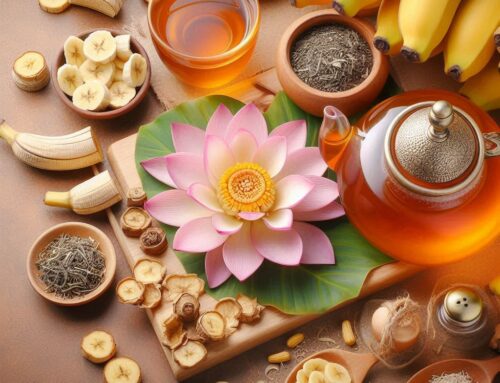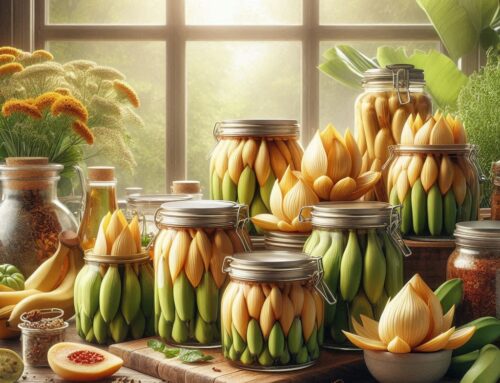
What is Banana Blossom?
Banana blossom, also known as banana flower, is an intriguing and versatile component of the banana plant that is gaining popularity in culinary circles. This large, purple-skinned flower grows at the end of a banana cluster and consists of tightly packed petals or bracts that encase a tender heart. But what exactly are banana blossoms? Essentially, they are the edible flower part of the banana plant, offering a unique texture and flavor profile.
The inner petals of the banana blossom can be consumed raw or cooked and are often used in various dishes across Southeast Asian cuisines. They have a slightly nutty taste with a hint of bitterness, making them an excellent addition to salads, stir-fries, and curries. Beyond their culinary appeal, banana blossoms are also valued for their nutritional benefits; they are rich in dietary fiber, vitamins A and C, potassium, calcium, and antioxidants.
Understanding the definition of banana blossom opens up new possibilities for incorporating this exotic ingredient into everyday meals. Whether you’re looking to explore new flavors or add a nutritious element to your diet, this edible flower part of the banana plant offers both versatility and health benefits worth exploring.
Nutritional Profile of Banana Blossoms
Banana blossoms, often overlooked in favor of the fruit they accompany, boast an impressive nutritional profile that makes them a valuable addition to any diet. These blossoms are rich in essential nutrients and provide a variety of health benefits.
One of the standout aspects of banana blossom nutrition is their high fiber content, which aids in digestion and promotes a healthy gut. Additionally, they are low in calories and fats, making them an excellent choice for those looking to maintain or lose weight without sacrificing essential nutrients.
Banana flowers are also packed with vitamins such as vitamin C and vitamin E. Vitamin C is crucial for boosting the immune system and promoting skin health, while vitamin E acts as a powerful antioxidant that helps protect cells from oxidative stress.
The mineral content of banana blossoms includes important elements like potassium, calcium, copper, phosphorus, iron, and magnesium. Potassium is vital for maintaining healthy blood pressure levels; calcium supports bone health; iron is necessary for producing red blood cells; while magnesium plays a role in over 300 biochemical reactions in the body.
Incorporating banana blossoms into your diet can offer numerous health benefits. Their nutrient-rich composition supports heart health by reducing cholesterol levels and regulating blood pressure. Moreover, they have been traditionally used to manage menstrual disorders due to their ability to balance hormones naturally.
Overall, banana blossoms provide an array of vitamins and minerals that contribute to overall well-being. Including them in meals not only adds unique flavors but also enhances nutritional intake significantly.
Common Uses of Banana Blossom in Cooking
Banana blossoms, often overshadowed by the fruit they accompany, are a versatile ingredient in many culinary traditions. Cooking with banana blossoms opens up a world of flavors and textures that can enhance your meals in unique ways. These blossoms are especially popular in Southeast Asian cuisines, where they feature prominently in salads, curries, and stir-fries.
One of the most traditional recipes using banana flowers is the Filipino dish kinilaw, a type of salad that combines the shredded blossom with vinegar, spices, and sometimes coconut milk for a refreshing yet tangy flavor profile. In Thailand and Vietnam, banana blossoms are often sliced thinly and added to fresh salads or soups to provide an interesting texture contrast.
Preparing banana blossoms for meals requires some careful handling. The outer layers should be peeled away to reveal the tender inner petals. These petals can then be soaked in water with a bit of lemon juice or vinegar to prevent discoloration before being sliced or chopped as needed for your recipe.
For those following a plant-based diet, banana blossoms serve as an excellent vegan meat substitute due to their hearty texture. They can be battered and fried to mimic fish fillets or used as a filling for tacos and sandwiches. Their ability to absorb flavors makes them ideal for marinades and seasoning blends.
Incorporating banana blossoms into your cooking not only diversifies your menu but also introduces you to new cultural tastes—making them an exciting addition to any kitchen repertoire.
The Safety of Consuming Banana Blossoms: What You Need to Know
Banana blossoms, often overshadowed by the fruit they accompany, are gaining popularity in culinary circles for their unique taste and nutritional benefits. However, before diving into a new recipe featuring banana flowers, it’s important to understand any safety concerns associated with their consumption.
First and foremost, banana blossoms are indeed edible and can be consumed either raw or cooked. However, many prefer cooking them due to their slightly bitter taste when raw. Cooking not only enhances their flavor but also makes them more palatable by reducing bitterness.
When it comes to safe preparation methods for consumption, it is advisable to remove the tough outer layers of the blossom until you reach the tender inner core. This part is typically more pleasant in texture and taste. Additionally, soaking the blossoms in water with a bit of lemon juice or vinegar can help reduce any residual bitterness.
While there are no significant safety concerns with eating banana flowers for most people, those with allergies to bananas should exercise caution as similar compounds may be present. As always, introducing any new food into your diet should be done gradually to monitor how your body reacts.
In conclusion, banana blossoms can be a delightful addition to various dishes when prepared correctly. By following safe preparation methods and being mindful of potential allergens, you can enjoy this exotic ingredient without worry.
Potential Side Effects and Allergic Reactions Linked to Banana Blossoms
Banana blossoms, often hailed for their nutritional benefits and unique flavor, are becoming increasingly popular in various cuisines. However, as with many foods, it’s important to be aware of potential side effects and allergic reactions that may accompany their consumption.
One of the primary concerns related to banana blossom side effects is the possibility of allergic reactions. Individuals who are allergic to bananas might also experience similar reactions when consuming banana flowers. Symptoms can range from mild itching or swelling around the mouth to more severe reactions such as hives or difficulty breathing. Therefore, those with known allergies to bananas should exercise caution and consult with a healthcare professional before incorporating banana blossoms into their diet.
Moreover, individuals with latex allergies should be particularly mindful. The proteins found in bananas and their flowers can sometimes cause cross-reactivity in people sensitive to latex, leading to allergic responses.
In addition to allergy concerns, certain groups should consider avoiding bananas and their flowers altogether. For instance, people on potassium-restricted diets due to kidney problems or other medical conditions might need to limit intake since both bananas and banana blossoms contain significant amounts of potassium.
While banana blossoms offer numerous health benefits, being informed about potential side effects ensures safe consumption for everyone who wishes to enjoy this exotic ingredient. Always consider personal health conditions and consult with healthcare providers if there’s any doubt about introducing new foods into your diet.
The Verdict: Are Banana Blossoms a Safe Addition to Your Diet?
Banana blossoms, also known as banana flowers, are gaining popularity as a unique and nutritious addition to various culinary dishes. But should you eat banana blossoms? Before incorporating this exotic vegetable into your diet, it’s important to consider several health factors.
Banana blossoms are rich in dietary fiber, antioxidants, and essential nutrients like vitamins A, C, and E. They have been praised for their potential benefits in promoting digestive health and boosting the immune system. However, like any new food item, especially those that are less common in Western diets, it’s crucial to be mindful of how your body might react.
Health considerations when adding new foods to your diet include potential allergies or intolerances. While banana blossoms are generally safe for most people when cooked properly, some individuals may experience adverse reactions due to specific sensitivities. It’s always wise to introduce new foods gradually and pay attention to any unusual symptoms.
Experts’ take on consuming exotic vegetables like the banana flower is generally positive but with a note of caution. Nutritionists often recommend diversifying one’s diet with a range of fruits and vegetables for optimal health benefits. However, they also advise consulting with healthcare professionals if you have underlying medical conditions or dietary restrictions.
In conclusion, while banana blossoms can be a safe and nutritious addition to your meals for most people, it’s important to approach them—and any new food—mindfully. By doing so, you can enjoy their unique taste and nutritional benefits while ensuring they complement your overall dietary needs effectively.






